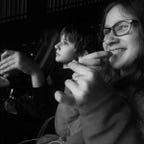Icons of survival: Richard Graves’ exhibit in Abingdon, 5 November 2021
“Remember, remember, the fifth of November”: perhaps there was something to the date of the opening of Richard Graves’ exhibit The Red Queen Effect at the Salt of the Earth Spa in Abingdon. Like Guy Fawkes, whose attempt to blow up Parliament failed on this day in 1605, this exhibit offers a cri de couer against the powers of its age; but instead of destroying anything, it lifts and ennobles those who find themselves chased by the Red Queen. The “red queen effect” in biology suggests that only organisms which adapt constantly will survive, and each portrait in this remarkable collection shows us an individual faced with her demands.
Curated by Summer Apostol with intriguing QR codes on playing cards related to each painting, the collection also points toward the incessant requirements of paid work (making reference to Max Weber’s notion of the “protestant work ethic”), and the constant pressure takes a toll on many of the figures represented here. Graves captures faces in moments of disarming honesty, some full of emotion, some uncertain, some weary. In some cases the emphasis is on the facial features themselves, set against roiling abstract backgrounds; in others, added media offer words to elucidate the quiet desperation behind the eyes. In one particularly striking image, a skull reveals shadowy figures within, the words “byss and abyss: nothing and all: time” standing as a banner at the top. Even in death, the Red Queen pursues her subjects.
Graves’ mastery of the face extends to its dislocation and distortion. Several portraits show us the effects of constant pressure in the tearing, the breaking, the blurring of their subjects. An image with the doubling of eyes and mouth left me feeling physically woozy, while a face separated into two parts seemed disturbingly familiar. Even distorted, though, these are real people with real feelings, and they are presented as such.
Indeed, the effect of the whole is that Graves has seen the persistent beauty of his subjects, in all the chaos and distress around them. We may not be able to escape the Red Queen’s tyranny, but we can find moments of quiet reflection in which to rebel against her demands of constant change, moments in which our frailty and honesty are elevated to luminous permanence. Each sitter in these paintings has protested by the simple act of being painted, and Graves has made them into icons of survival.
The tranquil surroundings of the spa make for a wonderfully ironic setting; here is a space of escape from the Red Queen, a place of placid stability in which to consider the paintings. Here you are invited to join the rebellion against her wearying commands by getting a massage. And that beats trying to blow up Parliament, by a long way.
The exhibit will run for about a month. I encourage you to go spend time with it.
